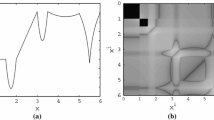Abstract
Commonly used computational and analytical tools for fitness landscape analysis of optimization problems require identifying a distance metric that characterizes the similarity of different solutions to the problem. For example, fitness distance correlation is Pearson correlation between solution fitness and distance to the nearest optimal solution. In this paper, we survey the available distance metrics for permutations, and use principal component analysis to classify the metrics. The result is aligned with existing classifications of permutation problem types produced through less formal means, including the A-permutation, R-permutation, and P-permutation types, and has also identified subtypes. The classification can assist in identifying appropriate metrics based on optimization problem feature for use in fitness landscape analysis. Implementations of all of the permutation metrics, and the code for our analysis, are available as open source.
Access this chapter
Tax calculation will be finalised at checkout
Purchases are for personal use only
Similar content being viewed by others
References
Campos, V., Laguna, M., Martí, R.: Context-independent Scatter and Tabu search for permutation problems. INFORMS Comput. 17(1), 111–122 (2005)
Caprara, A.: Sorting by reversals is difficult. In: Proceedings of the First International Conference on Computational Molecular Biology, pp. 75–83. ACM (1997)
Cicirello, V.A.: On the effects of window-limits on the distance profiles of permutation neighborhood operators. In: Proceedings of the International Conference on Bioinspired Information and Communications Technologies, pp. 28–35, December 2014. https://doi.org/10.4108/icst.bict.2014.257872
Cicirello, V.A.: The permutation in a haystack problem and the calculus of search landscapes. IEEE Trans. Evol. Comput. 20(3), 434–446 (2016). https://doi.org/10.1109/TEVC.2015.2477284
Cicirello, V.A.: JavaPermutationTools: a Java library of permutation distance metrics. J. Open Source Softw. 3(31), 950 (2018). https://doi.org/10.21105/joss.00950
Cicirello, V.A., Cernera, R.: Profiling the distance characteristics of mutation operators for permutation-based genetic algorithms. In: Proceedings of the 26th International Conference of the Florida Artificial Intelligence Research Society, pp. 46–51. AAAI Press, May 2013
Fagin, R., Kumar, R., Sivakumar, D.: Comparing top k lists. SIAM J. Discret. Math. 17(1), 134–160 (2003)
Hernando, L., Mendiburu, A., Lozano, J.A.: A tunable generator of instances of permutation-based combinatorial optimization problems. IEEE Trans. Evol. Comput. 20(2), 165–179 (2016)
Hunt, J.W., Szymanski, T.G.: A fast algorithm for computing longest common subsequences. Commun. ACM 20(5), 350–353 (1977)
Jones, T., Forrest, S.: Fitness distance correlation as a measure of problem difficulty for genetic algorithms. In: Proceedings of the 6th International Conference on Genetic Algorithms, pp. 184–192. Morgan Kaufmann (1995)
Kendall, M.G.: A new measure of rank correlation. Biometrika 30(1/2), 81–93 (1938)
Lee, C.: Some properties of nonbinary error-correcting codes. IRE Trans. Inf. Theory 4(2), 77–82 (1958)
Levenshtein, V.I.: Binary codes capable of correcting deletions, insertions and reversals. Sov. Phys. Dokl. 10(8), 707–710 (1966)
Meilă, M., Bao, L.: An exponential model for infinite rankings. J. Mach. Learn. Res. 11, 3481–3518 (2010)
Mitchell, M.: An Introduction to Genetic Algorithms. MIT Press, Cambridge (1998)
Ronald, S.: Finding multiple solutions with an evolutionary algorithm. In: IEEE Congress on Evolutionary Computation, pp. 641–646. IEEE Press (1995)
Ronald, S.: Distance functions for order-based encodings. In: Proceedings of the IEEE Congress on Evolutionary Computation, pp. 49–54. IEEE Press (1997)
Ronald, S.: More distance functions for order-based encodings. In: Proceedings of the IEEE Congress on Evolutionary Computation, pp. 558–563. IEEE Press (1998)
Schiavinotto, T., Stützle, T.: A review of metrics on permutations for search landscape analysis. Comput. Oper. Res. 34(10), 3143–3153 (2007)
Sevaux, M., Sörensen, K.: Permutation distance measures for memetic algorithms with population management. In: Proceedings of the Metaheuristics International Conference (MIC 2005), pp. 832–838, August 2005
Sörensen, K.: Distance measures based on the edit distance for permutation-type representations. J. Heuristics 13(1), 35–47 (2007)
Tayarani-N, M.H., Prugel-Bennett, A.: On the landscape of combinatorial optimization problems. IEEE Trans. Evol. Comput. 18(3), 420–434 (2014). https://doi.org/10.1109/TEVC.2013.2281502
Wagner, R.A., Fischer, M.J.: The string-to-string correction problem. J. ACM 21(1), 168–173 (1974)
Wright, S.: Evolution in Mendelian populations. Genetics 16(2), 97–159 (1931)
Author information
Authors and Affiliations
Corresponding author
Editor information
Editors and Affiliations
Rights and permissions
Copyright information
© 2019 ICST Institute for Computer Sciences, Social Informatics and Telecommunications Engineering
About this paper
Cite this paper
Cicirello, V.A. (2019). Classification of Permutation Distance Metrics for Fitness Landscape Analysis. In: Compagnoni, A., Casey, W., Cai, Y., Mishra, B. (eds) Bio-inspired Information and Communication Technologies. BICT 2019. Lecture Notes of the Institute for Computer Sciences, Social Informatics and Telecommunications Engineering, vol 289. Springer, Cham. https://doi.org/10.1007/978-3-030-24202-2_7
Download citation
DOI: https://doi.org/10.1007/978-3-030-24202-2_7
Published:
Publisher Name: Springer, Cham
Print ISBN: 978-3-030-24201-5
Online ISBN: 978-3-030-24202-2
eBook Packages: Computer ScienceComputer Science (R0)




